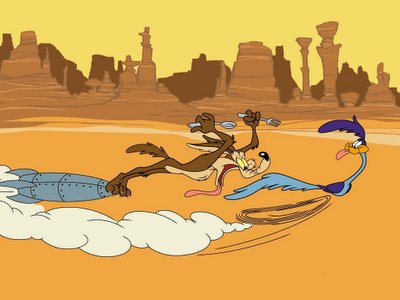
I got Volume 3 of the Looney Tunes Golden Collection this week, added to the first two volumes already in hand. That makes for 180 Looney Tunes now released on DVD. I know, I know; 40-something dude watching cartoons. But damn, they are just so very, very good. I have been a huge Looney Tunes fan for 35 years, and have only more recently discovered a love for the period of prohibition and the Great Depression and jazz; so perhaps I should more accurately say that cartoons led me back to the New York of the 1930s.
To my eye these shorts appear almost timeless, with things that give away their period--telephones and cars and modes of dress--passing incidentally and almost unnoticed. But watched closely, they're still a window to their times; and in light of my love of the period, I'm hyper-alert to all these passing details. The earliest Tunes date from the 30s and many of them are noticeably set in, you guessed it, New York. And in these we see the world of the Chrysler Building construction: skyscraper construction with steam shovels and buckets of hot rivets; candlestick phones; cars with their spare tires carried outside, above the back bumper; red brick construction; flowerboxes on the 8th floor, rickety steel fire escapes. The steel-framed skyscraper construction, so apropos to this little pairing, is one of the early Looney Tunes favorites, and there is a giddy sense of progress and modernity in the portrayals of this kind of very blue collar work.
But more generally, I don't think one watches Looney Tunes and feels predominantly the era of their creation; they aren't topically about time-specific things. And in visual style they changed little from beginning to end, a period of over thirty years! Of course, many of them are set in the woods or, with Chuck Jones's fantastic Road Runner shorts, in some weird Jetsons version of Monument Valley; these settings defy period association.

What flashes before us is a miraculous witches' brew of witty and subtle writing, sparse yet inspired artwork (both in the characters everybody knows and loves, and in the backgrounds which make a study in themselves), and voicework nonpareil. And as a sound-oriented person, I think the audio aspect of these shorts is entirely underrated. The use of music and foley is ground breaking and pure genius. And the voice work. I could happily listen to CDs of Mel Blanc's voicework much more readily than I could watch the cartoons without sound. Maybe that's just me.
 Each of the several directors had their particular schtick, expressed both in characters owned by them singularly (Chuck Jones and the Road Runner; Friz Freleng and Yosemite Sam) and also, most interestingly, in their individual takes on characters they all directed. Bugs Bunny is the best known of all Looney Tunes characters and also the best example of a character worked by every director and artist in the stables. And Bugs is subtly different under each director's hand. Chuck Jones was my favorite (though Friz Freleng had so many spectacular ones as well); he had this intellectual twist which is delicious when applied to cartoon characters. I especially love the word plays (Hah! That's it! Hold it right there! ...pronoun trouble.) and deadpan asides from the characters.
Each of the several directors had their particular schtick, expressed both in characters owned by them singularly (Chuck Jones and the Road Runner; Friz Freleng and Yosemite Sam) and also, most interestingly, in their individual takes on characters they all directed. Bugs Bunny is the best known of all Looney Tunes characters and also the best example of a character worked by every director and artist in the stables. And Bugs is subtly different under each director's hand. Chuck Jones was my favorite (though Friz Freleng had so many spectacular ones as well); he had this intellectual twist which is delicious when applied to cartoon characters. I especially love the word plays (Hah! That's it! Hold it right there! ...pronoun trouble.) and deadpan asides from the characters.Here's to a good laugh!

Some Looney Tunes / Merrie Melodies facts:
--Looney Tunes were produced from 1930-1969.
--Over 1,000 shorts were produced during this time period.
--11 cartoons ("the censored 11") were removed from circulation in 1968 because of ethnic stereotypes.
--Speedy Gonzales shorts were removed from circulation in 1999 for the same reason.
--Most of the above have been returned to circulation now.
--Some of the most popular and enduring characters in American culture resulted from these labors: Bugs Bunny, Daffy Duck, Porky Pig, Elmer Fudd, Yosemite Sam, Foghorn Leghorn.

3 comments:
This post gave me a whole new appreciation for Looney Tunes.
What were the ethnic stereotypes? I'm curious. Looney Tunes seems so innocent that it's hard to imagine them as offensive in anyway.
I agree. Looney Tunes are awesome! They taught me a lot about classical music. Remember the one with the swans that was performed to the Blue Danube Waltz? I also love the little owl singing, "I wanna singa, about the moona and the joona and the swinga. I want a singa about a sky so blue and me and you and I a love to, I a love to siiiing!"
So many of the cartoons had amazing political commentary (not the ones mentioned above).
Lizzie: I think most the ethnic sterotypes were Al Jolsen blackface-type characters. And some with young black children not characterized all that nicely (think Little Rascals).
Some quick research:
The owl cartoon is called, "I Love to Sing-A" and is based on the song by the same name by Al Jolsen. This version is sung by Owl Jolsen.
The Blue Danube is part of a cartoon named, "A Corny Concerto". I believe the first part has the classic lyric, "kill the wabbit, kill the wabbit."
Also fantastic is the "Rabbit of Seville" performed to "The Barber of Seville" and the "Marriage of Figaro".
Post a Comment